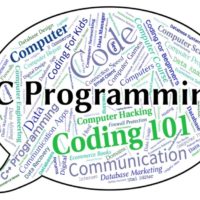Artificial Intelligence is the next big thing. Almost every tech company is investing in AI, and it’s transforming everything from transportation to healthcare. It can also be an excellent way for anyone to make money online.
But before someone dives into this exciting world, there are some things they should know about programming languages for artificial intelligence first.
Choosing the correct language for a person’s needs is essential because different languages have strengths and weaknesses that might not work well with what they want to do. Here are seven of the best programming languages for artificial intelligence.
1. JavaScript
JavaScript is an essential programming language for web development, but it’s also great for AI. For example, it can create chatbots and even develop virtual assistants like Siri. In addition, JavaScript has access to the internet to collect data in real-time, which makes it a valuable tool for AI developers and coders who want to create virtual assistants or other kinds of information retrieval bots.
An example of using JavaScript in AI is IBM’s Watson. It’s a quiz show-winning supercomputer that can answer questions asked in natural language.
2. Python
Python is another excellent coding program language for artificial intelligence because of its simplicity, making it easy to learn and code. It also has access to several open-source libraries useful for machine learning, data mining, pattern recognition, image processing, statistical modeling, and much more.
One example of using Python in AI is Carnegie Mellon University researchers who have created an engine called SyntaxNet, which learns how languages work by looking at the raw text from Wikipedia articles. This model allows them to develop chatbots that can speak English and other languages like Spanish.
Ruby
Ruby is one of the lesser-known programming languages for AI, but it’s still worth mentioning. It works great for building chatbots and other conversational software.
In addition, Ruby works well with NLP (natural language processing) and machine learning applications. However, it’s challenging to master because of its nonlinear object model that changes under certain conditions.
C++
C++ is a general-purpose programming language that has been around since 1978 and was designed to speed up systems software development by giving programmers direct access to memory and hardware instructions (and the operating system).
C++ is used everywhere and, in all products, from websites to video games. In addition, it’s useful for AI applications like neural networks and parallel processing tasks. However, C++ is less efficient than other programming languages because it requires more memory to run.
Java
Java is one of the most popular programming languages globally and has been around since 1995. It’s a general-purpose language that makes it easy to build complicated applications and websites. Java’s core class library system has thousands of built-in APIs (applications programming interfaces) that allow programmers to do almost anything they could imagine.
Using Java with AI allows finding resources such as data analysis, creating data visualization, or machine learning algorithms without starting from scratch, which saves time and money.
C#
Every developer should know about C# because it’s one of Microsoft’s most prominent languages used to create applications for Windows and other platforms. It allows using Visual Studio to develop computer programs with ease. One of C #’s strengths is its similarity to Java while still reducing the number of bugs in code during compilation by preventing many common errors like null pointer exceptions.
Using C# with AI benefits developers who want to use machine learning or data analysis without hassle. People can easily set up an application or experiment with new models thanks to tools like R Tools that simplify machine learning tasks, allowing adding powerful algorithms to C# apps.
C
At first glance, a person might think that C is just another general-purpose programming language like Java or Pascal. Still, it’s better for creating applications because it’s designed to be fast and efficient. It’s also helpful in working with devices thanks to the Unix operating system where C was developed.
For example, the Linux kernel (embedded software found in electronic devices like printers and computers) is written mainly in this language, perfect for building low-level AI applications that need fast response times using less memory than Python or Ruby.
Conclusion
Many programming languages are used for AI, but understanding their differences can be difficult. Whether a person is new to the topic or a seasoned expert, this article has summarized the most significant pros and cons of each one so that anyone can choose which language is best for their needs.
Some are good for building large-scale applications, while others are more suitable for helping beginners develop something quick, easy, and efficient. While learning one of these languages takes time, it’s worth it in the end because they all play an essential role in creating intelligent machines.



